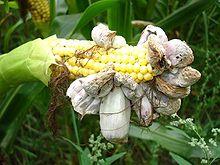Ustilaginomycotina
| Ustilaginomycotina | |
|---|---|

| |
Ustilago maydis
| |
| Scientific classification | |
| Domain: | Eukaryota |
| Kingdom: | Fungi |
| Division: | Basidiomycota |
| Subdivision: | Ustilaginomycotina Doweld (2001) |
| Classes/orders | |
Malasseziomycetes
Monilielliomycetes
| |
The Ustilaginomycotina is a subdivision within the division
Ustilaginomycotina comprises 115 genera with more than 1700 species.
Morphology
Ustilaginomycotina is morphologically a highly diverse group. It consists of two states: anamorphic yeast state and teleomorphic filamentous smut state.[7] These two states in the life cycle can look very different.
Defining features
The Ustilaginomycotina has different ultrastructural morphologies that defines the subdivision and some of them are also used to delimit the classes in the subdivision.
Cellular interaction
The cellular interactions are referring to the interaction between the
Cellular composition
Ustilaginomycotina has a distinctive cell wall composition consistent of mostly glucose and absence of xylose. This character separates the Ustilaginomycotina from Pucciniomycotina and Agaricomycotina.[9]
Septal pores
The architecture of the septal pores plays an important part in delimiting the subdivision in Basidiomycotina. In contrast to the Pucciniomycotina, the Ustilaginomycotina has a septal pore with a membrane cap or it is poreless. It does not have a
5S rRNA
In 1985 Gottschalk and Blanz did a study about the 5s ribosomal RNA and distinguished two types of structures in the Basidiomycota. These two types was named the type A secondary structure and the type B secondary structure of the 5S rRNA. This is a useful tool for delimiting between the subdivisions. The Ustilaginomycetina has the type B secondary structure and they share this character with the Agaricomycotina, and it separates them from the Pucciniomycotina which has the type A secondary structure.[11]
Classification
Historic classification
In 1847 Tulasne and Tulasne divided the so-called smut fungi into two groups called Ustilaginacceae and Tilletiaceae.
With the use of
Modern classification
Ustilaginomycotina consists of both anamorphic yeast species and teleomorphic filamentous smuts.[1][7] These two states can look very different and is not always easy to connect. The two different states has therefore produced different names on the same species. With the use of both morphological characters and molecular data, the subdivision is now reclassified and many of the species has been renamed by the 'One Fungus = One Name' principle.'[2]
By looking at ultrastructural morphological structures like host-parasite interactions, the septal pore apparatus[1][10] and molecular sequence analysis a new classification was proposed. Here Ustilaginomycotina consisted of the three classes Ustilaginomycetes, Exobasidiomycetes and Entorrhizomycetes.[7] But, the presence of Entorrhizomycetes was questioned and are now considered as incertae sedis in the Basidiomycota.[5]
In 2014 a new multiple gene sequence analysis showed that two additional classes, forming two independent deep lineages should be recognized as classes in the subdivision:
Ecology
Distribution
Since Ustilaginomycotina is mostly plant parasites, the group is restricted to the host species of
Role in the environment
Ustilaginomycotina have an array of plant pathogens, and some are parasitizing on economically important species like wheat, barley and corn. In some cases the yield loss is minimal, in other the crops has to be quarantined. Some of the galls produced by the smuts is considered as a delicacy in some parts of the world. Malassezia lineages also causes harm on human skin.
Life cycle
The life cycle of the subdivision is
Species from the subdivision obtained from the nature will often be in the yeast-like state.[6][14][15]
References
- ^ doi:10.1139/b97-842.)
{{cite journal}}: CS1 maint: multiple names: authors list (link - ^ PMID 26955198.)
{{cite journal}}: CS1 maint: multiple names: authors list (link - ^ PMID 25737592.
- ^ S2CID 26613287.)
{{cite journal}}: CS1 maint: multiple names: authors list (link - ^ S2CID 4686378.)
{{cite journal}}: CS1 maint: multiple names: authors list (link - ^ a b Bauer, R., Begerow, D., Oberwinkler, F. (2008). "Ustilaginomycotina R. Bauer, Begerow, J. P. Samp., M. Weiß & Oberw. 2006. The true smut fungi". The Tree of Life Web Project.
{{cite web}}: CS1 maint: multiple names: authors list (link) - ^ PMID 17486967.)
{{cite journal}}: CS1 maint: multiple names: authors list (link - doi:10.1139/b95-095.)
{{cite journal}}: CS1 maint: multiple names: authors list (link - doi:10.2323/jgam.39.1.)
{{cite journal}}: CS1 maint: multiple names: authors list (link - ^ JSTOR 3760941.)
{{cite journal}}: CS1 maint: multiple names: authors list (link - ^ Gottschalk, M. & Blanz, P.A. (1985). "Untersuchungen an 5S ribosomalen Ribonucleinsäuren als Beitrag zur Klärung von Systematik und Phylogenie der Basidiomyceten". Zeitschrift für Mykologie. 51: 205–243.
- ^ Tulasne, L.; Tulasne, C. (1847). "Mémoire sur les Ustilaginées comparées Uredinées". Annales des Sciences Naturelles. Botanique. 3 (7): 12–127.
- ^ Vánky, K. (2003). "Cintractiellaceae fam. nov. (Ustilaginomycetes)". Fungal Diversity. 13: 167–173.
- ^ a b c Begerow, D., Göker, M., Lutz, M., Stoll, M. (2004). "On the evolution of smut fungi on their hosts" (PDF). Frontiers in Basidiomycote Mycology. pp. 81–98.
{{cite book}}: CS1 maint: multiple names: authors list (link) - ^ a b Begerow. D., Schafer, AM., Kellner, R., Oberwinkel, D., Bauer, R. (2014). The Mycota, Vol. VII, Part A: systematics and evolution. Ustilaginomycotina (2nd ed.). Berlin, Germany: Springer-Verlag. pp. 295–329.
{{cite book}}: CS1 maint: multiple names: authors list (link)
